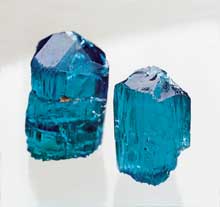TOURMALINE: All the Shades of the Rainbow
Tourmaline occurs in a wider range of colors than any other gemstone. Although the general public does not know tourmaline as well as some other gems, it is increasing in popularity. The fashion industry, with its increasing use of bright colors in clothing, has created an unprecedented demand for brightly colored natural stones, which has benefited this lovely gemstone. Tourmaline's name comes from the Sinhalese word "turmali," which means "mixed." Bright rainbow collections of gemstone varieties were called "turmali" parcels. Originally, native miners applied this term to mixed parcels of gems when they didn't really know exactly what the stones were.
Tourmaline occurs in virtually every known
gemstone color, with more than 120 distinct hues reported. Greens, blue-greens, blues and
pinks are typical, and these are the most in demand commercially. The red shades are also
in great demand, but are rare and harder to acquire. The tourmaline palette also includes
lesser known shades of yellow, orange, brown, violet and other subtle colors that one
would expect to find in a rainbow, rather than a jewelry shop. Many tourmalines are color-zoned; a cut gemstone may
therefore display several hues, sometimes with the color bands sharply delineated.
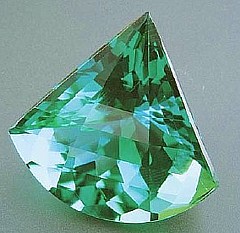
Ruby and spinel are priced at levels of thousands of dollars per carat. Red tourmaline of a similar color therefore, at several hundred dollars per carat, remains an attractive value and one that has significant potential for price appreciation. Red tourmalines, especially ones that resemble fine ruby, are so rare that they are almost never seen in jewelry stores, and remain essentially unknown to the public. Typical rubellite colors include pink, rose-red and violet, and intermediate shades. The chemical impurities that color a tourmaline red or pink are detrimental to the stable growth of the material in its natural environment. These impurities cause a growing tourmaline crystal to become internally flawed or cracked; the more the impurity is present, the darker the red color, and the more imperfect the final crystal. It is therefore extremely rare to find dark violet, pink or red tourmalines that are "clean" internally. Some day in the future the gemstone market will be fully aware of this fact, and fine rubellite will be priced accordingly.
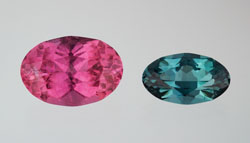
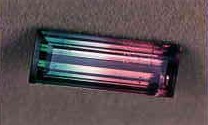
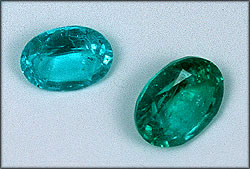
Tourmalines are found mainly in Brazil, Sri Lanka, Africa and the
U.S. In 1822, red and green tourmaline was discovered in Maine and as this new source
produced sufficient quantities of gemstones, a new market was created and gave tourmaline
value. California became a large producer of tourmaline in the early 1900s. Maine produces
beautiful sherbet colors of tourmaline and spectacular minty greens. California is known
for perfect pinks, as well as beautiful bicolors. During this time, Maine and California
were the worlds largest producers of gem tourmalines. The Empress Dowager Tz'u Hsi, the
last Empress of China, loved pink tourmaline and bought almost a ton of it from the then
new Himalaya Mine, located in San Diego County, California. The Himalaya Mine is still
producing small quantities of tourmaline today.
Almost every color of tourmaline can be found in Brazil, especially in Minas Gerais and
Bahia. In 1989, miners discovered tourmaline unlike any that had ever been seen before.
The new type of tourmaline, which soon became known as Paraiba tourmaline, came in
incredibly vivid blues and greens. The demand and excitement for this new material, which
soon fetched more than $10,000 per carat, earned more respect for the other colors of
tourmaline. A recent African discovery has produced tourmaline colored
by copper, similar to the Brazilian Pariba. Its colors are somewhat less
bright and it commands a lesser price (though still high by comparison to
most tourmaline). In addition to Brazil, tourmaline is also mined in Tanzania, Kenya,
Madagascar, Mozambique, Namibia, Afghanistan, Pakistan, Sri Lanka. One particularly
beautiful variety is chrome tourmaline, a rare type of tourmaline from Tanzania which
occurs in a very rich green color caused by chromium, the same element which causes the
green in emerald.
Tourmaline is the most common boron bearing silicate mineral and is almost exclusively found in geological formations known as pegmatites, where gem quality stones occur in open pockets in the pegmatite dikes. The color in tourmaline is a result of substitutions of various transition elements or metals in the crystal structure. It is not uncommon that a pocket of Tourmaline crystals may contain stones several different colors.
The Great Morro Redondo Discovery
In the early 1990s, a huge find of deep Pink to
Red tourmaline was made at Morro Redondo, Brazil. It was one of the largest tourmaline
finds ever made, and we have a separate web page on the Morro Redondo occurrence, as most
of the tourmaline we have for sale here at Nevada Outback Gems is from that location. You
can view the special Morro
Redondo web page by clicking on the link right HERE.
TREATMENTS FOR TOURMALINE
The color of tourmaline can sometimes be improved by heat treatment and or irradiation. These treatments are often permanent and generally accepted in the gemstone trade. However, only a comparatively small portion of tourmaline gemstones on the market are treated by either heating or irradiation - most, especially the green colors, are natural.
Natural Tourmaline crystals are sometimes very beautiful, pencil thin and ridged, and they are sometimes set in jewelry in their natural form. Any of the Tourmaline colors can be used as one of the birthstones for October. Tourmaline is also the 8th wedding anniversary Gemstone. Tourmaline is one of the accepted birthstones for October and the accepted anniversary gemstone for the eighth year of marriage. Some designers also set rainbows of tourmaline in each color of the spectrum. A "rainbow" bracelet of 30 or more tourmalines, each one a different color, is an ideal gift for very special occasions! Tourmaline jewelry should be cleaned in warm, soapy water with a soft brush. Do not clean tourmaline a home ultrasonic machine, especially rubelite. It is also sensitive enough that it should be protected from scratches and sharp blows.
